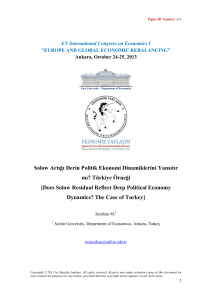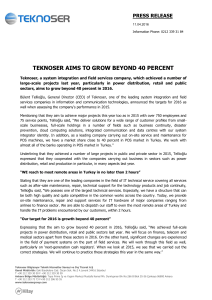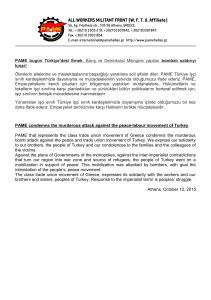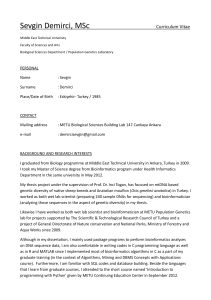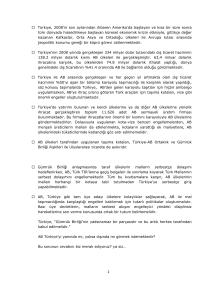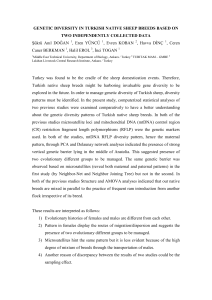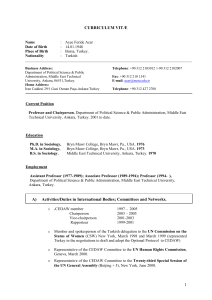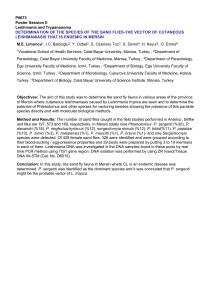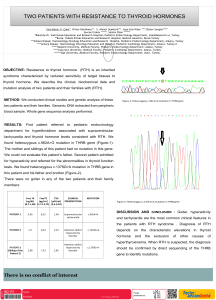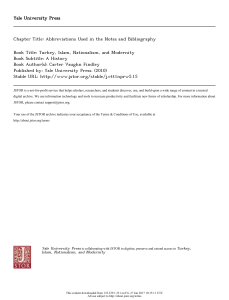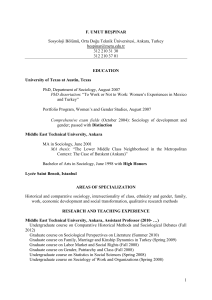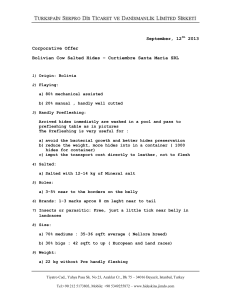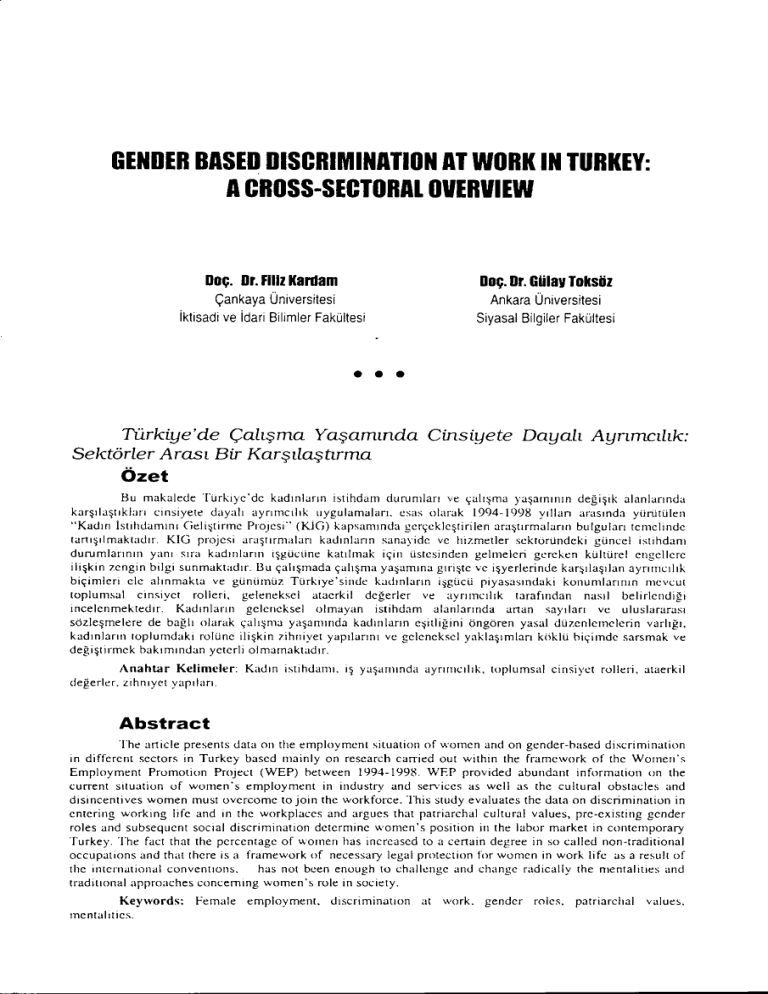
GENDER BASEO OISCRIMINATION AT WORK IN TURKEY:
A CROSS-SECTORAl OVERVIEW
Doç. Dr. Rllz Kardam
Doç. Dr. Gülav Toksöz
Çankaya Üniversitesi
iktisadi ve idari Bilimler Fakültesi
Ankara Üniversitesi
Siyasal Bilgiler Fakültesi
•• •
Türkiye'de Çalışma Yaşamında Cinsiyete Dayalı Ayrımcılık:
Sektörler Arası Bir Karşılaştırma
Özet
Bu makalede
karşılaştıkları
"Kadın
Türkıyc'de
cinsiyete
İsııhdamını
tanışılmaktadır.
dayalı
(ieliştirıne
KIG
projesi
kadınların
ayrımcılık
Projesı"
istihdam
(KIG)
araştırmaları
kadınların
biçimleri
alınmakla
cinsiyet
ve günümüz
rolleri,
ıncelenmektedır.
Kadınların
ataerkil
gerçekleştirilen
gelenekselolmayan
istihdam
Anahtar
zıhnıyeı
değerler,
Kelimeler:
yapıları.
Kadın
istihdamı,
ıŞ yaşdmında
yürütülen
bulguları
temelinde
sektöründeki
piyasasındaki
ayrımcılık
güncel
anan
istıhdam
engellere
ayrımcılık
konumlarının
tarafmdan
alanlarında
sôzleşmelere
de bağlı olarak çalışma yaşaınında
kadmiarın
eşiıliğini
kadınların
toplumdakı
rolüne ilişkin zihniyet yapılarını
ve geleneksel
değişıirmek
hakımından
yeterli olmamaktadır.
alanlarında
arasında
gelmeleri
gereken
kültürel
ve işyerlerinde
karşılaşılan
işgücü
ve
değişık
yılları
araşıırmaların
ve hızmetler
kadınların
değerler
yaşamının
ı998
i994-
için üstesinden
yaşamına gırişte
Türkıye'sinde
geleneksel
ve çalı~ma
olarak
sanayide
yanı sıra kadmların
ışgücüne
katılmak
bilgi sunmaktadır.
Bu çalışmada
çalışma
ele
esas
kapsamında
durumlarının
ilişkin zengin
toplumsal
durumları
uygulamaları,
nasıl
sayıları
mevcut
belirlendiğı
ve
uluslararası
ôngôren
yasal düzenlernelerin
varlığı,
yaklaşımları
köklü hiçimde sarsmak ve
ayrımcılık,
toplumsal
cinsiyet
rolleri,
ataerkil
Abstract
The aniele
in differem
Employment
current
presents
sectors
Promotion
sıtuation
data on the employment
in Turkey
based
Project
of women's
mainıyon
(WEP)
employment
situation
research
hetween
1994-1998.
in indusıry
of women
cdrried
and
and on gender-hased
out within
WEP
provided
services
discrimination
the framework
as well
abundant
of the Woınen's
information
as the culıural
on the
obstacles
and
dısincentives
women must overcome
to join the workforce.
This study evaluates
the data on discriminaıion
in
entering
working
life and in the workplaces
and argues ıhaı patriarchal
cUllural values, pre-exisıing
gendcr
roles and subsequent
Turkey.
The
occupations
socıal
discriminatıon
fact ıhat the percenıage
dnd ıhdl [here is a framework
the interlldtiondl
conventıons.
tradiııonal
approaches
coneemmg
Keywords:
mentalııies.
remale
deıermine
of women
women's
has increased
of necessary
position
ıo a cenaİn
legal proıeetion
has noı been enough to challenge
women's
role in society.
employment.
dıscriminaııon
al
in the lahor
in coııtemporary
in so called
for women
in work
dnd changc
work.
market
degree
gendcr
radically
roles,
non-traditional
life
as a resulı of
ıhe mentaliııes
paıriarchal
and
values,
152 •
Ankara Ünıversitesi SBF Dergısı.
59-4
Gender Based Discrimination at Work in Turkey:
A Cross-Sectoral Overview
Introduction
1.1. Focus of Studies on Women's Employment
The discrimination
women have to face in the labor market has long been
a subject of study for economists and social scientists. With the increase in
labor force participation
of women in developed countries, studies began to
dea i wİth the causes of different fonns of discrimination
such as wage
differences,
occupational
segregation
and restricted career opportunities
of
women. Feminist
scholars highlighted
the relationship
between
women' s
gender-based
responsibilities
(such as housework
and childeare)
and their
disadvantaged
position in the labor market.
In many developing countries both the participation
of women in the
labor market andthe percentage of women with paid work is lower than they
are in the developed countries and in general related statistical data on gender
basis is lacking. Since discrimination
begins with the low participation
of
women in labor force, most of the time the focus of research in these countries
has been on the rates of participation in the labor forcc, the sectoral distribution
of the labor force, employment
status and unemployment.
Turkey as a
deveJoping country shows similar characteristics.
Research on women's labor and employment
in Turkey began in the
midst of seventies and it was influenced from the second wave of feminist
movement. Boserup' s (1970) marginalization thesis was used to explain the low
level of women' s labor force participatİon and the stabilization
of women' s
employment (in a limited degree) in non-agricultural
activities (ÖZBAY, 1998).
In 1980s, within the context of globalization
and structural adjustment
policies, tlexibility has taken mainly the form of informalization
and female
labor force has been utilized extensively in developing countries producing and
Filiz Kardam - Gülay Toksöz.
Gender Based Discrimination at Work ın Turkey: A Cross-Sectora/ üvenııew
•
153
exporting for the world markets. This in turn has resulted in an increase in
women's
participation
in lahor force while the participation
of men has
declined. Consequently,
a rise in male unemployment and a deerease in female
unemployment
could be observed (ST ANDING, 1989, 1999; UN, 1999). At
this point, the situation in most of the Middle Eastem countries and Turkey
differs from that in most of the developing countries as the female participation
rates in labor force remain low. Only in the last few decades womcn's share of
employment
has been increasing in this group of countries (especially Arab
countries) as well from 22 percent in 1970 to 27 percent in i995 (UN, 1999:8).
This rate which is higher in Turkey with 31 percent has not shown any increase
in the last decade.
The studies dealing with the dimensions of change in the composition of
labor force in manufacturing
industry and the influence of structural adjustment
policies in Turkey (ÇAGATAY/BERİK,
1991, 1994; ÖZAR, 1994; ECEVİT,
1998a) have shown no notable alteration in the position of the female labor
force. While employment
in agriculture
has declined slowly in time, an
outstanding increase in women's employment outside agriculture could not be
observed in the period of export oriented growth modeL. This was basically the
outcome of the fact that the expected increase in industrial investments has not
taken place due to various economic and financial
factors (ŞENSES, 1996).
One of the indicators of this is that Turkey has not been a country which
attracted foreign direct investments comparcd with other countries. Not being
one of the favourite destinations for foreign capital flows Turkey has increased
its foreign capital stocks to 16,6 billion dollars in twenty years, an amount
which China attracted in onlyone year (2002) (www.treasury.gov.tr).
Most of
the foreign direct investments
in develaping
countries has be en in laborintensive industries such as textiles, clothing, electronics etc. whose labor force
is predominantly
female (UN, 1999: 5). Due to the insignificance
of foreign
direct investments
in Turkey the demand for female labor remained very
limited with same exceptions in garment industry.
In the context of globalization female emploYl11ent in the service sector
especially in banking and insurance services which employ relatively high
proportions of women in qualitied positions has increased all over the world
(UN, 1999: ll). The situation also found its ref1ections in Turkey. Rapidly
expanding service sector especially in financial services and in information
processing brought employment opportunities for a large number of qualified
women İn urban areas. Banking sector can be given as an example. The
proportion
of women employed increased from 33 percent in 1984 to 39
percent in 1994 and reached 50 percent in 2002 in private banks. In the same
154 e Ankara
Üniversitesı SBF Dergısı e 59-4
period this rate has remained relatively stable with 32-33 percent in the public
hanks (www.tbb.org.tr).
In countries where the agricultural sectar employs an important part of
the labar force, the female labor force increases very slowly outside the
agricultural sector (HORTON, ı999) and the labor farce participation of
women is influenced by many intertwining demographical and social factors
ineluding
those related
to women's
responsibilities
ın the family
(TZANNATOS,
ı999). Bath of these explanations are applicable to the
situation in Turkey. Women who are productively engaged in rural arcas find
themselves outside the production process in the urban are as where their family
has migrated for palitical or economical reasons. This is caused not only by the
insufficiency of paid work apportunities which would encourage women to
work in urban areas, but also and mainly by the existing patriarehal mentalities
which are unfavorable to women's wark ..
This artiele argues that in eontemporary Turkey, cultural values, preexisting gender roles and subsequent social discrimination
stili determine
women' s position in the labar market whether theyare qualified or unqualified.
lndispensability
of domestic labor and prevalent eultural norm s defining
women' s primary role as mother and housewife explain their disadvantaged
and subordinated position in the labor market. A large number of women
cannot even leave the domestic sphere and those who are educated and work as
skilled personnel stiıı face various forms af discrimination
at wark. The
discriminations in terms of entering work and for various issues at work will be
overviewed depending on the results of different investigations done under the
Women's Employment Promotion Project (WEP) in Turkey during ı994- ı998
which is the first over all systematic approach to the employment issues of
women in Turkey. This alsa means that we shall be limited with the areas
investigated İn the WEP project and the discriminatory practiees at wark will
be illuminated by taking mainly cases from the formaııy organized sector in
industry or services.
1.2.
WEP:
A
Comprehensive
Project
on
Women's
Employment
Ta understand the causes of law female participation in the labar market
was one of the aims of the Women's Employment Promotion (WEP) Project
and the studies conducted within the project highlighted the issue of powerful
Filiz Kardam - Gülay Toksöz e Gender Based Discrımination at Work in Turkey: A Cross-Sectoral Overview e
155
gender roles preventing women from undertaking income earning activities.!
The general aim of WEP can be summarized
as understanding
the current
situation of women's employment and developing related policy proposals in
order to increase the total number of employed women and to supply women
with better career opportunities and jobs.
Presence of aresearch advisory commİttee including people from private
and public sectors and NGOs who could contribute to the project with their
academic, administrative
and technical expertise on employment,
labor and
related issues gaye a chance to the project team of WEP and the implementing
government agency DGSPW to formuiate the research priorities and topics by
taking into consideration
the needs and tendencies
of
a wider group of
stakeholders as well as creating an awarencss and legitimization
of the project
İn wider circies.
WEP was planned as an action oriented research project and therefore the
individual researchers were expected to design
their research strategies not
only for the satisfaction of academic curiosity and interest, but also with the
perspective of formulating policy proposals to empower women in working life.
While studying both the demand and supply aspects of women's Iabor, the
researchers were also expected to approach the employment situation of women
sociologically rather than in pure economic terms.
A discussion on methodology was considered an important part of the
research process in WEP and in ord er to grasp the problem with a feminist
perspective the research team s (academicians from universities and/or research
experts from private and public sector) were encouraged
to use qualitative
research techniques
such as in-depth interviews and focus groups besides
quantitative methods (ATAUZ et aL., 1998).
The research topics in WEP were categorized under three main headings
systematically
related with one another to give a general picture of women' s
employment İn Turkey from different aspects. These headings were:
iThe WEP was one of the eight components of the Training and Employment
Project.
which was an umbrella project financed through a loan agreement between Turkey
and the World Bank in 1993. A series of research activities were accomplished
in
WEP which were planned, monitored and evaluated by a technical assistance team
together with the Directorate General for Women's Status and Problems (DGSPW),
the national machinery
for women which acted as the implementing
government
ageney. The authors of this artiele worked as local research consultants of WEP in the
technical assistance team for four years.
156 _ Ankara
Ünıversitesı SBF Dergisi _ 59-4
1) less known features of women's
prospective
demands
2) relationship
employment
(such as unemployment,
for female Iabor),
between
female education
and
vocational
training
with
employment,
3) sectar
branches
and
employer
studies
(such
as discrimination
in different
of work).
In each of these categories several
summing up to a total of 16 investigations.
II. Women's
Current
Employment
Developments in the Turkish Economy
research
projects
Situation
111
were conducted
the
Light
of
To give a short summary of the economic situation in Turkey can help us
to have a clearer understanding of the labor market pasition of women. Up until
1980, Turkey has followed a protectionist
import substitution growth model
based on internal accumulation
and appropriate distribution relations. While
domestic demand for commodities
and services were crucial in this system,
wages and income of small producers were kept high enough to create the
sufficient demand. Under strong labor unions there was a steady rise in real
wages and the prices of agricultural
products
were supported
by state
subventions.
Women's
employment
rates were low in this period mainly
depending on the fact that the main income camers, namely the husbands'
wages were considered sufficient for the living of the family. The tremendous
growth of foreign currency deficit gaye the first signal
for the end of this
development strategy.
In January 1980 a new phase began with the adaptation of structural
adjustment policies imposed from the World Bank and IMF to all developing
countries of the world. According to these policies Turkey had to adapt an
export-Ied growth model, in which all state incentives were to be directed to the
promotion of exports and other foreign currency bringing undertakings.
To be
competitive in the world markets exportable commodities and services had to
be produced with law costs. This meant a new pattem of distributive relations
in which the wages and the prices in all sectors (especially in the agricultural
sector) producing the inputs of the manufacturing
industry were kept under
control. The economİc program also included downsizing the state, reducing
the public expenditures
and privatizing the main economic enterprises of the
state. The military putsch of September ı980 created the suitable conditions for
the implementation
of this program by ruling out all types of social opposition
and imposing restrictions on the labor union activities.
A\though the implementation
of this growth model led to an incrcase in
exports, Turkey had bccome one of the unstable countries of the developing
Filiz Kardam - Gülay Toksöz.
Gender Based Discrimination at Work ın Turkey: A Cross-Sectora/ Overvıew •
157
world with a huge burden of extemal debts. Frequently faced with economic
crises, the increased impoverishment
of people has manifested
itself in high
unemployment
rates and a very uneven income distribution.2 Inereasing poverty
led the households to new income generatİng strategies such as men looking for
additional jobs; women, children and the retired entering the labor market and
a general reduction of household expenditures. Women with children usually
preferred to do home-based work or do more work at home for their famihes to
replace the commodities
and services bought from the market. Those who
looked for paid work were usually employed in domestic services or in the
smail workshops in the informal sector since the number of jobs in the formal
sector were insufficient.
Within the framework
of these economic
developments,
the 1999
statistics (which are more reliable compared with the statistics collected after
the economic crisis in 2000-2001) ret1ect that the (abor force participation of
women in Turkey is 29.7 percent, with only 35 percent of all working women
being occupied in income caming activities. Participation
in the (abor force
varies in urban and rural arcas, the proportion being lower in the urban areas. In
rural areas the participation
in the labor force is as high as 47.6 percent and
drops to i5.8 percent in urban arcas. The difference in the participation rates
between rural and urban is primarily influenced by the migration from the rural
to the urban areas. Most of the women
employed İn agricultural activities in
rural areas are out of the labor force in cities. Also the unemployment
rates
reach their highest levels in urban areas especially for women with 16,4 percent
(men 10,6 percent).
In 1999, the total labor force is 23,779,000, with 30.9 percent women
(7,353,000).
While women comprise 40.4 percent of the total labor force in
rural areas, this proportion drops to 20 percent in urban areas. The total urban
female labor force sums up to 2,2 15,000.
2 In 1999 Turkey had with 188.3 billion USD the 22nd biggest GNDP among the
counlrİes of the world, however witlı an 2900 USD per capita income it took the 43rd
row, being placed among the lower-middle
income countries. External debt stocks
amounted to 102 billion USD, being the eighth highest indebted country in the world.
Regarding income distribution
in 2000 the highest income quinlilc (the richest 20%)
of the society received 54.9 percent of total income, while the Iowest income quintile
(poorest 20%) received only 4.9 percent. Share of the lower and middle income
groups of the society (the remaining 60 %) was 40.3 percent. With this uneven
income distribution
Turkey has the 191h position among 92 countries of the world
(SÖNMEZ, 2001: 109-119)
158 _ Ankara
Üniversitesi SBF Dergisi _ 59.4
The employment in various sectors shows that for men, the service sector
is the most important source of employment, followed by agriculture and then
industry. For women, agriculture stilI keeps its dominant position although its
importance
in employment
has deelined through the years. About 2/3 of
employed women are unpaid family workers in smail family businesses in
agriculture
or services.
Table 1: Employment
by Different Sectors and Status in Employment
Sectür
Total
Female
Male
Agriculture
45,8
20.5
33,7
72,2
9,7
18,1
33,8
25,4
40,8
41,0
29,4
25,3
9,7
48,2
38,3
29,6
65,1
13,5
Industrv
Services
(%)
Status
Salaried
worker
Self
employed/cmplüyer
Unpaid
family
worker
Source: SiS, HLFSR, Apri11999,
pp.16-21
Bearing in mind that there are significant differences among women not
only between rural and urban arcas but also among geographical regions, social
elass and strata, an overview of the occupational distribution of urban women in
Turkey can also point out to some particularities. While unpaid family work in
agricultural activities and very low educational levels are determining women's
labor in rural areas, most of the female (abor force in urban areas is educated
beyond primary school (59.6 percent) with 3/4 (74.5 percent) being salaried
employees. When the distribution of women according to occupational groups
is considered,
it will be observed that there is a concentration
of female
workers in middle rank qualified posts such as scientific, technical, professionaJ
workers and elerical workers (42.2 percent). This is the point where the
difference of Turkey is most striking from developing countries at similar levels
and even from some of the developed countries. 38.2 percent of scientific.
technical, professional and related workers as well as 38.1 percent of elerical
and related workers are women. Women are largely represented in both groups
whereas their share among production workers is relatively limited with 10.3
percent. On the other hand women' s proportion among entrepreneurs,
directors
Filiz Kardam - Gülay Toksöz e Gender Based Dıserimınalion at Work ın Turkey A Cross-Seetoral Overview e
and high !evel managers is 10.5 percent,
countries of the world (SIS, 1999: 105).
159
a rate as low as in most of the other
In i995, the proportions in some of the specialized professions revcal
that 28 percent of the lawyers, 39 percent of the architects, 13.5 percent of the
engineers, 39 percent of the dentists and 33 percent of the academicians
are
women (KAGITÇIBAŞI,
1999: 261). These statistics ref1ect that 'horizontal
segregation'
which refers to the distribution
of men and women across
occupations is relatively low in Turkey although it is highest in the Middle East
and North Africa according to UN Report (1999: 17). This situation suggests
that social, historical and cultural factors are important in determining the level
of occupational
segregation by sex. An explanation of this distinctiveness
in
Turkey
could be sought in the efforts of the families especiaBy in middle or
higher income levels to educate their daughters for professional occupations in
line with Atatürk's reforms since the establishment of the Republic. Within the
framework of 'westemization'
efforts and the ideology of the Republic, women
have come forward in the public sphere by taking advantage of laws related to
civil rights and education. The concrete results of this ideology has been in the
speciaIization
of women in scientific, technical and professional occupations.
Predominantly
urban
women
and women
from
middIe
and
upper
socioeconomic
classes have benefited from the educational opportunities
and
specifically from higher education. 3
The inereasing proportion of female university students after 1980s in
branches which are traditionally
male-dominated
could also be interpreted as
areflection
of the continuation of this tendeney. In 1999-2000, the proportion
of female students was 47 percent in mathematical
and natural sciences, 43
3 The reforms which carried women to the public sphere and the indination
of women
towards specialized professions during the establishment
of the Republic have been
considered
most!y as part of the women's
liberation
movement.
Yet different
evaluations
have been made at the end of the 70's and during the 90's. In these
evaluations
the fact that the transformation
was class based and that the Atatürk's
reforms have been inadequate
in modifying
the status of women radically
and
annulling
the gender roles in the division of labor
within the family have been
opened to discussion
(ÖNCe,
1982, TEKELI,
1991, KANDlYOTI
1991. 1998,
ARAT, Z, 1998, ARAT, Y., 1998, SIRMAN 1989, KADIOGLU,
1998). In the final
analysis as some of the researchers have alsa agreed, these improvements
have been
considered
useful, particularly
for the urban women to appear in the public sphere
whiıst taking advantage of the educational opportunities.
In the long term, this has
opened the path for legitimizing the existence of women in the working life and for
eradicating
the prejudices
towards
women
who work İn traditionally
male
professions.
160 e Ankara
Ünıversitesı SBF Dergısi e 59-4
percent in social sciences, 32 percent in agıiculture and forestry, 23 percent in
technical sciences.
In branches such as architecture, chemical engineering,
chemistry, mathematics and management the proportion of the female students
is higher than the overaıı average of female students in the universities which is
40 percent (TAN, 2000: 53).
III. Discrimination in Entering the Work Life and at
Work
The relatively low level of increase in the number of both employed and
unemployed
women when compared with the increase in the urban female
population is related both with the low level of demand for women's work and
the discouraging
conditions of the limited number of jobs offered in terms of
wages, benefits and service s for child care. This low level of participation is
also intensified on the supply side of women's labor with social and cultural
obstacles caused by their gender roles and the understanding
of these roles in
the society. Along this line, one of the important social obstacles İs that
women's decision to work depends on men's permission and it is in general
under their control. That women internalize their role as housewİves
and
mothers and are less eager to work outside also creates another obstacle.
According to the findings of one of the research projects under WEP
titled
"Socio-economic
and Cultural
Dİmensions
of Urban
Women's
Participation in Working Life" which İs conducted in four big cities of Turkey
has retlected that while 44 percent of women who have never worked and not
looking for a job currently have acted on their own free \Viıı, 47 percent were
not aııowed by their families and social circumstances
(ÖZAR et aL., 2000:
71).4 However, the major reason beyond
women's
decision not to work was
again the desire to take care of their home and family. The impact of social
pressure negatively affecting women's employment is intensified in settlements
where migrants coming from the same rural areas liye in close neighbourhoods.
Another study on unemployment
under WEP was "Urban Women and
Change as Potentİal Labor Force".5 The study has revealed that 58.7 percent of
4 In this project data was coııected by a quota samplc from i i 2S women through face
to face interviews in Istanbul, Ankara, İzmir and Adana. The quantitative information
was eıırichcd with qualitative data coııected from five focus groups, two life histories
and 25 in-depth iııterviews with women in IstanbuL.
5 The data in this project \Vas collected mainly through a surveyand a fcw focus group
discussions. The field survey was done in ıo municipalities
in Istanhul and the
sample was selected af ter a screening survey of 6643 women in the age groups 15-49.
Filiz Kardam - Gülay Toksöz e Gender Based Dıserimınalıon at Work in Turkey A Cross-Seeloral Overview e
161
unemployed women think that a woman needs her husband's permıssıon to
work and this rate increases to 71. 9 percent among housewi ves (DEMIREL et
al., 1999: 209-210). As the age and the educational1evel of unemployed women
increase, the proportion of those thinking that the consent of husband is a
necessity decreases. 87.3 percent of women without any formal educational
degree and 19.4 percent of the university graduates think that such a permission
is essential (DEMİREL et. aL., 1999: 211).
Gender roles not only prevent a large number of women from entering
the labor market, but also affect the permanence of their work. The reason for
half of the women (55 percent) quitting work for a certain period of time is
family and/or children. while 77 percent of such women have mentioned not
being able to find a person or place to tak e care of their child. Most women
receive the greatest encnuragement from their mothers to continue with work
and theyare essentially helped along by their mothers or mother-in-laws when
childcare is necessary (ÖZAR et aL., 2000: 39). Women with children have
problems in meeLİng the expectations of employers because of long working
hours (, especially in the private sector and this creates an obstacle in terms of
being hired. Women's approach to wages is alsa shaped in relation to their
considerations about childeare. Especially married women with young children
expect to receive a salary which definitely exceeds their chi1dcare expenses
and other work related expenses. Otherwise, af ter calculating their losses and
their gains, they prefer to stay at home and take care of their child. On the other
hand, younger women who do not have the responsibility of children seem
more willing to accept lower wages (ÖZAR et aL., 2000: 94-95).
ıv.
Forms of Discrimination in the Workplace
IV.1. Legal Framework
In general it can be said that the Labor Lawand related regulations in
Turkeyare treating men and women as equals. Besides "The Conventian on the
Eliminatian of all Forms of Discrimination Against Women" (CEDA W), which
has been effecti ve si nce October 14, 1985, foresees the prevention of all sorts of
discrimination in the workplace, as in all other aspects of social life. Various
Among thcsc 200 housewives. ı08 unemployed, 439 marginal workers, 21
underemplayed and 32 long time unemployed workers who wcre included in the final
samplc werc interviewed through face to face questionnaires.
6 The lega! wark time in Turkey is 8 hours a dayand 45 hours a week. However many
workers especially in the private sector have to work much longer without any
overpayment in order to keep their jobs.
162 e Ankara
Üniversitesi SBF Dergisı e 59-4
ILO conventions
and Council
of Europe resolutions
also entrust
the
governments to make the necessary arrangements to prevent discrimination.
On
the other hand, the existence of different forms of discrimination
in wark life
can be taken as an indication of the fact that legal equality does not ensure
equality
in practice.
Discriminatory
practices against women in the workplace
become
manifest during hiring, promotions, attitudes towards requests for permission,
appointments,
early retirement and dismissal from work. Sexual harassment of
women in the workplaces is also a factor which discourages women to take a
step toward work life outside her home.
IV.2 Hiring
While the discrimination
of women in workplaces takes different forms
in each sector, it fails to be prevented even in the wark branches with a high
concentration
of women workers. A good example for this is the banking
sector where a large number of women with high educational
levels are
employed
at relatively favorable working conditions.
One of the research
projects in WEP which studied the female bank employees has indicated that
during the hiring process, the most obvious discriminatory
practices were:
Hiring women in general as ordinary employees (categories of more routine
work) and men as experts with higher chances of promotion to management
positions; loading routine work upon women because theyare considered to be
more patient; placing good looking women at the front desks as a showcase and
not employing women as inspectors (a position with more control power and
prestige also demanding
travel to other regions where branch offices are).
Women were even asked in interviews during hiring not to have any children
for some time (EYÜBOGLU et aL., 2000).7
Several women
as follows:
have related their experiences
and views on these issues
" We spoke to the manager. 'Do you have any children?' he asked. i
said i have two. He asked 'Do you want any more') if so, i won't hire
you.' i rcplied 'No, l' m not planning to have more.' 'Well then, we' il
7 In this project titled "Gender
Discrimination
in the Banking Seetor" data was
eolleetcd in two stages: first, two publie hanks and one pıivatc bank with different
eharaetcristies
were selectcd and a questionnaire
was applied to 265 employees, hoth
mak and female. Among thesc, a group consisting
of 28 mak and 39 female
employees
including
those in executiye
positions
was selected
and in-depth
interviews were carried out.
Filiz Kardam - Gülay Toksöz _ Gender Based Discrımination at Work in Turkey A Cross-Sectoral Overview _
get this thing arranged' he said." [39 years old, married,
school education 1 (EYÜBOGLU et. aı., 2000: 57).
163
with high
" The number of women starting out as clerks is so high. None of my
male colleagues
started as ordinary employees.
Account expert,
inspector. .. all good posts, and now theyare
all directors, deputy
directors. (... ) Men always have a better status." [ 32 years old, not
married, with university educationl (EYÜBOGLU et. aı., 2000: 64).
Other
research
projects
under WEP reflected
similar
situations
.experienced
by women applying for other, less traditional occupations.
A
woman looking for a job as a metallurgical engineer explained:
"i went with my husband to a glass-aluminum factory in Bursa for a
job interview. They thought he was the engineer. i said, no, i'm the
one. The men were horrified. 'lmpossible', they said. i asked ' Did you
make it clear in your ad that you wouldn't want a woman employee?'
They answered that they had n 't even imagined that a woman would
apply. They said 'Our workers, they swear, we can't forbid the m
because there is a woman araund.'
So, to have the freedom of
swearing is more important!"
[35 years old, married, long term
unemployed] (ÖZAR et aı., 2000: 126).
IV.3 Wages
iıi
I
it is difficult to make a comparative analysis of wage differentials and
changes in wages in time because systematic and comprehensive
data on gender
basis does not exist. However, wage statistics related with different economic
activities show that starting with Ottoman times, there was always a significant
gap between the wages of men and women. Starting with 1951, although the
governing statuses regulating the minimum wages have stated that there will be
no difference between the men's and women's minimum wages, in practİce
these principles were not abided and the difference between wages went up to
100 percent (MAKAL, 2001: 144). In 1957, when the wages of female and
male workers in different branches of economic actİvity are compared,
in
industıies where the number of female workers is larger such as the food
industry the wages are 55.1 percent of men's; in tobacco industry, 60.5 percent;
in textile industry 75.4 percent; in clothing 72.4 percent (MAKAL, 2001: 146).
Comparing
the wages in the pubIic and private sectors, one can see that the
wage levels are significantly higher in the public sector, but the gender gap in
wages continues
(MAKAL, 2001: 148). The differences are mainly due to the
fact that in the above mentioned branches of industry, women are employed as
~~~~_se_m_i_-S_k_il_ıe_d_o_r_u_n_Ski_'_Iı_ed~w_o_rk_e_rS_(_M_A~K_A_L_'_2_0_0_1:_1_5_1_).
_
164 _ Ankara
Üniversitesi SBF Dergisi _ 59-4
More recent statistics reflect that there are stiIl important differences
between the wages of men and women. According to the 1994 Wage and
Employment Structure Statistics of the State Institute of Statistics, hourIy wages
of female workers insured by the Social Security Institution are to a great
degree lower than those of mal e workers (61.4 percent). On the other hand, it is
observed that the disparity is less between the wages of ma!e and female civil
servants or employees
working on contract basis who are covered by the
Retirement Fund (TÜRK-İş,
1999: 394).
It can also be observed that the increase in the educational levels of
women has contıibuted to a certain degree to close this gap, especiaIly in the
public sector. In 1994, the monthly wages of university graduated women in the
public sector is 76 percent of men at the same educational !evel, while it is 68
percent in the private sector. At higher administrative
positions the wages of
women get closer to men's especially in the public sector with 95.6 percent,
while it İs 84 percent in the private sector (ECEVIT, 2000: 168-169).
Anather study based on the data from the 1987 Household Income and
Consumption
Expenditure
Survey finds the earnings gap between ma!e and
female workers as 40 percent and at aIl educational levels women tend to eam
less then men (K.ASNAKOULU/DAYIOULU,
1997: 100). While 40.5 percent
of the eamings gap can be explained by the variables of human capital such as
schooling, experience
etc., the rest difference is a result of discrimination
against women in the labor market (KASNAKOULU/DA
YIOULU, 1997: 116).
The most common practice which opens the way to wage differences
between men and women is the concentration of women in non-qualified,
low
paid sectors and occupations, due to the distinction made between "men's jobs"
and "women' s jobs". Women usuaIly work without any form of social secuıity.
Accordi ng to the data of SIS (1996: 55), the percentage rate of urban women
working without social security has been 56.3 compared to 29 percent in men
during 1988-1993.
The WEP project also included an investigation
which aimed the
evaluation
of job guarantied
vocational training courses organized by the
Turkish Employment
Agency. According to the results of this investİgatİon,
young girls and women who have been provided with work af ter getting their
certificates from the Turkish Employment Agency's courses on computer aided
accounting, textile and tourism, were generally employed with low payments
and without social security although they were employed in workplaces in the
formal sector. 65 percent of the trainees continued to work in their first jobs
Filiz Kardam - Gülay Toksöz.
Gender Based Dıscrimination at Work ın Turkey: A Cross-Sectoral üvenııew •
165
af ter finishing the course and 35 percent changed their workplaces (AKHUN et
aL., 1999: 127).R The most important reasons mentioned by the trainees for
changing workplaces were: "low wages" (47.5 percent), "finding a job with
higher wages and better work conditions"
(41.7 percent), "the unfair and
authoritarian
attitudes of their managers" (30.8 percent), "having no social
security" (27.5 percent), "working under the burden of duties umelated with
their vocational training" (20.8 percent) (AKHUN et. aL., ı999: 135).
The results of another research project under WEP, conducted in the
various branches of food industry (such as dairy, Oour, tobacco, fruit and
vegetables) where women workers are highly concentrated.,
have reflected that
half of the female workers are paid minimum wages (KORAYet
aL., 1999: 160161). 9 Yet the proportion of men working with minimum wages among the
male workers in the same branches is not only lower (l8 percent), but the range
in wages is also wider. By providing men with a different status, permanent
staff positions and thus higher wages, their commilment
to the workplace for
longer duration is ensured (KORAYet.
aL., ı999: 162). It has also becn
observed that the proportion of women working with minimum wages is even
higher, up to 80 to 100 percent, in workplaces not affiliated to labor union s and
in those which work mostly under subcontracting conditions.
Arather indirect indication of the employment of women with low wages
and without social security is also found in Özar et aL. (2000: 45) and Demirel
et aL. (1999: 1 ı7) studies, which have been mentioned before.
Both of these
studies have reflected that around 40 to 50 percent of unemployed
women
surveyed had previously worked without social security. They also found out
that the pıimary requirement of women looking for work was to find "a job
with social security". While 63 percent of women loaking for work preferred a
8
In the research
"Contribution
of Vocational
Training
Courses
to Women's
Employment"
the target of investigation were female trainees who have attended job
guaranteed
courses in new developing
areas of work as well for more traditional
vocations. The samplc was selected among traİnecs who participated
these courses
during 1993- i 994 iıı four cities of Turkey. The quaııtitativc data was collected from
304 employed
traiııecs aııd 56 not employed
trainees as well 31 employers,
24
training course orgaııizers and 52 traiııers.
9 The study titled "Conditions
of Womeıı in Food lııdustry aııd Their Future" was
carried out iıı İzmir. The sample of the study was selected among regular and
seasonal workers from 8 firms includiııg public and privatc enterprises.
Data was
collected from 350 female and 100 malc workers through face-to-face
standardized
questionııaires.
Alsa in-depth
iııtcrvicws
were carried out with 5 women from
differcııt firms on their work histories aııd changiııg conditioııs of work.
166 e Ankara
Ünıversitesi SBF Dergisı e 59.4
lower paid job with social security, only 29 percent have said that they would
prefer a well paid job even if it is without social security (DEMIREL et aL.
1999: 182).
The investigation in the banking sector has show n that in spite of its
formally
institutionalized
structure and employment of a large number of
qualified female labor force, the wage discrimination between men and women
stilI exists but in an indirect way through favoring men in promotions, in
compensations and other practices increasing their wage levels. In the in-depth
İntervİews one of the female employees expressed her views on the wage
differences as follows:
"There is no difference between the net wages of men and women.
But there are differences in the compensations
we receiye. For
example there is a compensation you receiye when you earn points
depending on your aptitudes. But there are some points that are totally
left up to the decision of the manager. (...) Men have the priority when
it comes to these points. Our assistant directors meet to give us points.
Even if you, as a woman, have better qualifications,
men always get
higher points. They favar men. They say 'He's a man, he supports a
family'. My assistant director once expressed this to me by saying
'come on, what do you need the mo ney for?'. Both ma1e and female
managers believe a woman has some material support anyway." [36
years old, married, university graduate, assistant to department
manager] (EYÜBOGLU et aL., 2000: 181)
In the study in health sector, which is also a sector employing a high
proportion of women, it has also been observed that female doctors are
discouraged to choose a field of expertise such as orthopedics, urology, surgery
which usually bring higher incomes, even though there is no official difference
between men's and women's wages (TULUN et aL., 2000: 83-84).10
IV.4 Promotion
Studies conducted
in various lines of work have indicated that
promotions of women at the workplace are alsa negatively affected by their
gender role. Especially the study conducted in the banking sector provides us
10 The project "Women in the Health Sectar" was a qualitative study based on data
from medical and non-medical
personnel from S public and S privatc hospitals in
IstanbuL. 36 women and 16 men were interviewed in-depth and alsa S focus groups
were organized.
Filiz Kardam - Gü/ay Toksöz e Gender Based Discrimination at Work in Turkey: A Cross-Sectoral Overview e
with many examples. One of the employees
with women's promotion as follows:
has explained
the problems
161
related
"A woman will inevitably need maternal lcave or medical leave
during pregnancy, delivery and afterwards. She will then be away
from her job for a certain period and miss out on so me opportunities.
There are general examinations
at the bank every 3 to 4 years.
Colleagues having reached a certain position take part in the m and are
promoted. We have many female colleagues who couldn't take part in
the examinations
because of their pregnancy or delivery and whose
chances for promotion have been weakened" L 29 years old, marıied,
university graduate] (EYUBOGLU ct aL., 2000: 62).
In addition to malc managers' prejudices and negative attitudes towards
them, women themselves usually act as the society in general expects from
them as 'women' and as a result, they do not apply for positions of work which
may demand more responsibility,
long hours of work and travel. The hard work
and efforts which women need to put into their work in order to reach
managerial levels of ten discourage them since they also have the responsibility
of caring for their home and family. An executive woman has stated:
"To reach this position i had to work three times as much as aman.
Three of the men who started out as experts at the same time with me became
deputy directors at least five years before mc. That's how they became unit
directors much before me. Different interactions, different influences affect this
process. You realize this, but you can 't do anything to overcome it" [40 years
old, not married, university graduate, assistant director with 16 years of work
life] (EYÜBOGLU
et. aL., 2000: 202).
Women have usually stated reasons such as missing the examinations of
promotion because of maternal leave, not being able to participate in training
programs in other provinces, not being hired as inspectors from the start as
reasons delaying their promotion. On the other hand, male employees in the
same study have usually explained the difficulties
women face in being
promoted to managerial positions with their limited interest and understanding
of politics and especially the political maneuvers which are of ten employed
during this process.
v.
Conclusion: Mentalities
Fostering Discrimination
and the Strategies to Struggle Against Them
In his artiele entitled "Aspects of Industrial Life", Laurence S. Moore has
described the working life of women in Istanbul in 1920s as follows:
168 _ Ankara
Üniversıtesı SBF Dergısi _ 59-4
"As an excuse for paying women lower wages, some employers say
that women accept lower wages than men because they mostly stay at
home. It has been expressed a few times that female workers, as a
rule, do not behave professionally at work, considering work only as a
temporary occupation until they get marrİed. In eastem countıies it is
stilI almost uni'iersally believed that a woman's destiny is marriage"
(MOORE, 1995: 165).
The period mentioned by Moore is the beginning of 20th century. Now,
one can tak e a look at the viewpoints of two men, first one being the
representatiye of alabor union and the second one the manager of a bank with a
large number of female employees, cvaiuating women' s work at the end of the
century:
"A woman should balance her work according
to her duties at
home. (... ) i don't agree that men should participate in housework.
The woman should work outside considcring her responsibilities
at
home. She can work anywhere, OK. But she should adapt her job to
her activities at home. She should have a job that doesn 't keep her
from doing the housework. That's the kind of job she needs. That's
the rule. Men have the primary responsibility
of the family. So
women should have the responsibility of the household
management
and things such as cleaning and washing" (KOZAKU
et aL., 1998:
135). II
"Which
professions
should women enter? They should become
teachers. Then they have more time left for their work at home. And
since they're more patient they'lı make good teachers. A mother's
loye for children is different than that of a father. Women should give
love to their children, take care of them. This is the ıight thing to do."
[50 years old, married, university graduate] (EYUBOGLU
et aL.,
2000: 59).
The statements indicate that women's position in the working life is still
being evaluated in the same way by giYing the priority to their role as mothers
ıi
The project "Labor Unions and Polİtical Parties: Institutiona! Traditions and
Cognitivc Structures With Particular Reference to Women' s Employment"
was a
quaJitative study. The data was collected through discourse ana!ysis from the
programs and other documents of labor unions and politica! parties and alsa through
in-depth interviews with the representatives of different !abor unions and peop!e
holding various organizational positions in different political parties.
Filiz Kardam - Gülay Toksöz.
Gender Based Discrımination at Work ın Turkey A Cross-Sectoral Overvıew •
169
and housewi ves which is considcred
thcir primary sociaııy accepted duty.
These vicwpoints also manifest the attitude of men in decision-making
Ievels to
preserve their advantaged pasition by deeming women suitable to inferior jobs,
putting barriers to women who want to enter "their" jobs and emphasizing how
women
are different from men because of their "natural" roles as wives and
mothers (RESKİN,
1991). Of course this doesn't
me an that nothing has
changed since the beginning of the century. Compared to that period alarger
number of women in Turkeyare
working in various sectors, including nontraditional ones and although limited in number, some have reached quite
influential positions. Despite the insufficiency of existing laws, women have
not only more permanent and irreplaceable positions but also more security in
working life, at least in the formal sectar.
However, the fact that the percentage of women has increased to a
certain degree in so called non-traditional
occupations
and that there is a
framework of necessary legal protection for women in work life as a result of
the international
conventions,
this is not enough to challenge and change
radically the mentalities and traditional approaches concerning women's role in
society.
First of aıı the Turkish industry
has not been successful in creating
employment
opportunities
in the last twenty years. This is especiaııy true for
women, hecause even in the sub-scctors of the economy which have shown
some development
in certain periods, the demand for female women workers
remained very limited. Therefore, the unqualified women were mostly left with
the choice of working in the informal sector with lower wages and usuaııy
without any form of social security either outside their homes or home-based.
This is a disadvantaged
position for women from the start not only because of
economic reasons such as lower wages and lack of security, but also because
these forms of labor also strengthen the beliefs that women' s place is primarily
her home and her position in the labor market outside home is marginal and
temporary. lt is also true that \vomen themselves are likely to prefcr such jobs
to be able to carry their domestic chores, especially the care activities. Nonemarket care activities (taking care of the children, the old aged people and the
ili) of women did not change through the years; in fact in the periods of
economic crisis, the domestic work load of women increased considerably since
most of the services provided in the welfare states of the developed world to
support women's care activities at home are stiıı very insufficient in Turkey.
Besides the negative conscquences of the existing economy, it should be
emphasized
that the values about the gender roles in the society are well
established
in the organizations
where policies related with conditions
of
employment,
legal rights at work, wagc levels ete. are determined. Thercfore,
170
e Ankara Üniversıtesı SBF Dergisı e 59-4
even if the international conventions open new horizons, the policy decisions
and the actual practice may lag behind.
On the other hand, women work in higher status occupations espeeially
in the public sector in Turkeyand this is the seetor where the wage differences
between men and women is lower. However, the share of the public seetor in
employment
is decreasing;
it is not providing sufficient
employment
opportunities and the number of upper position management jobs for women
are very limited. Although the number of female students in many new nonetraditional branches in the universities has been inercasing, by itsclf, this can
not be taken as 'good news' regarding women' s employment.
if new
investments are not directed to sectors which eould also demand qualified
women in relatively
higher positions, new perspectives
for women's
employment cannot be expected in the near future. In this process, it is vitally
important to hear voices from decision-making positions for policies supporting
women.
As the new developments in the economies all over the world confront
women with new forms of labor which see m to be more suitable to their gender
roles and therefore more likely to be preferred by them: at the same time they
define women as unskilled cheap laborers by lowering their wages, cutling
down on social protection, restricting promotion, organization ete. which in no
way servc to change women's status and role in the society. Future research in
Turkey should study more decply what is happening to women's employment
wİthin the framework of global economic developments and the trends of
development in the Turkish economy. This will refleet to us the perspeeti ves of
development in the informal and formal sectors, new occupations and new
forms of labor espeeially in the services, what is ehanging in terms of
discriminations at work (if any) and which faetors are affecting this change.
References
AKHUN, 1.1 KAVAK, Y.I SENEMOGlUI N. (1999), Işgücü Yetiştirme
Katkısı (Ankara: KssGM).
Kurslarının
Kadın Istihdamına
ARAT, Yesim (1998), "Türkiye'de Modernleşme Projesi ve Kadınlar," BOZDOGAN, 5.1 KASABA, R.
(Eds.), Türkiye'de
Modernleşme
ve Ulusal Kimlik (istanbul:
Tarih Vakfı Yurt
Yayınları):82-98.
ARAT, Zehra (1998), "Kemalizm ve Türk Kadını," HACIMiRZAOGlU, A. (Ed.), 75 Yılda Kadınlar ve
Erkekler (istanbul: Türkiye Ekonomik ve Toplumsal Tarih Vakfı): 51-57.
ATAUZ, A. i KARDAM, F. i TOKSÖZ, G. (1998), "Kadın Araştırmalarında Yöntem Sorunu ve Kadın
istihdamının Geliştirilmesi (KiG) Projesi Örneği," Iktisat Dergisi, 377: 16-25.
BOsERUP, Ester (1970), Woman's Role in Econamic Development
(New York: St. Martin Press).
ÇAGATAY N. i BERIK, G. (1991), "Transition
to Export-led Growth
Feminizatıon of Employment?," Capital and Class, (11 :3).
in Turkey:
Is There
a
111
Filiz Kardam - Gülay Toksöz e Gender Based Dısenmınation at Work ın Turkey A Cross.Seetoral Overview e
ÇAGATAY, N. / BERIK, G. (1994), "Structural Adjustment,
Manufacturing,"
SPARR, P. (Ed.), Mortgaging
Struetural Adjustment (New York: Zed Press).
Femjnjzatjon and Flexjbility in Turkish
Women's Lives, Feminist Critiques of
ÇiNAR, Mjne (1994), "Unskilled Urban Mjgrant Women and Disgujsed Employment:
Women jn Istanbul, Turkey," World Development, 22/3: 369-380.
Home Workjng
DEMIREL, A. / KAYAALP-BILGIN, Z. / KOCAMAN, M., et aL. (1999), Çalısmaya Hazır Işgücü Olarak
Kentli Kadın ve Değişimi (Ankara: KSSGM).
ECEVIT,
Yıldız (1998a),
"Küreselleşme,
Yapısal Uyum ve Kadın Emeğjnjn Kullanımında
Değişmeler," ÖZBAY, F. (Ed.) Kadın Emeği ve Istihdamındaki
Değişmeler (istanbul:
insan Kaynağını Geliştjrme Vakfı):31-77.
ECEVIT, Yıldız (1998b), "Türkiye'de
Ücretli Kadın Emeğjnjn Toplumsal Cjnsiyet Temelinde
Analizi," HACIMIRZAOGLU, A. (Ed.), 75 Yılda Kadınlar ve Erkekler (istanbul:Türkiye
Ekonomjk ve Toplumsal Tarih Vakfı):267-284.
ECEVIT, Yıldız (2000) "Çalışma Yaşamında Kadın Emeğjnjn Kullanımı ve Kadın-Erkek Eşjtliği,"
Kadın-Erkek
Eşitliğine
Doğru Yürüyüş:
Eğitim,
Çalışma
Yaşamı ve Siyaset
(istanbut:TÜSiAD): 117-191.
EYÜBOGLU, D. / KUTES, Z. et aL. (2000),
(Ankara: KSSGM).
Bankacılık
Sektöründe
Cinsiyete
Dayalı Ayrımcılık
HORTON, Susan (1999), "Marginaljzation
Revisjted: Women's Market Work and Payand
Development,"
World Development, 27/3:571-582.
Economjc
KADlOGLU, Ayşe (1998), "Cinselliğin
inkarı: Büyük Toplumsal Projelerin Nesnesi Olarak Türk
Kadınları," HACIMIRZAOGLU, A. (Ed.), 75 Yılda Kadınlar ve Erkekler (istanbul:Türkiye
Ekonomik ve Toplumsal Tarih Vakfı):89-100.
KAGITÇIBAŞI, Çiğdem (1999), "Türkıye'de
Kadının Konumu: insanca Gelişme Düzeyj, Eğjtim,
istihdam, Sağlık ve Doğurganlık," RONA, Z. (Ed.), Bilanço 1923-1998 (Istanbul: TÜBA,
TSBD, Tarih Vakfı):255-266.
KANDIYOTl, Deniz (1991), "End of Empire: Islam, Nationalism and Women in Turkey,"
D. (Ed.), Women, Islam and the State (London: Mc Millan Press).
KANDIYOTl,
KANDIYOTl,
Denjz (1998), "Modernjn
Cinsiyetj: Türk Modernleşmesj
Araştırmalarında
Eksik
Boyutlar,"
BOZDOGAN, S. /KASABA, R. (Eds.), Türkiye'de
Modern/esme ve U/usal
Kimlik (istanbul: Tarih Vakfi Yurt Yayınları): 99-117.
KASNAKOGLU, Z. / DAYlOGLU, M. (1997), "Female Labor Force Partjcjpatjon
and Earnjngs
Differentjals
between Genders jn Turkey,"
RIVES, J.M. / YOUSEFI, M. (Eds.),
Economic
Dimensions
of
Gender
Inequality.
A
Global
Perspeetive
(Connect1cut:Westport):
95-117.
KORAY, M. / DEMIRBILEK, S. / DEMIRBILEK, T. (1999), Gıda Işkolunda
Geleceği (Ankara: KSSGM).
Kadınların
Koşulları
ve
KOZAKU T. / ÜSÜR, S. et aL. (1998), Işçi Sendikaları ve Siyasal Partilerde Kurumsal Gelenek ve
Zihniyet Örüntülerinin
Kadın Istihdamına Etkileri, Report (Ankara: KSSGM).
MAKAL, A. (2001), "Türkiye'de
1950-65 Döneminde Ücretli
SBFDergisi,56/2:117-155.
Kadın Emeğine ilişkin Gelişmeler,
MOORE, L. S. (1995), "Sanayi Yaşamının Bazı Yönleri," JOHNSON, C. R.
(istanbul: Tarjh Vakfi Yurt Yayınları): 147-174.
(Ed.), Istanbul
"
1920
ÖNCÜ, Ayse (1982), "Uzman Mesleklerde Türk Kadını," ABADAN-UNAT, N. (Ed.), Türk Toplumunda
Kadın (Ankara:Türk Sosyal Biljmler Derneği):271-286.
ÖZAR, Şemsa (1994), "Some Observations on the Posjtion of Women in the Labor Market in the
Development Process of Turkey," Boğaziçi Journal, 8/1-2:5-19.
ÖZAR, S. / EYÜPOGLU, A. / TUFAN-TANRIÖVER, H. (2000), Kentlerde Kadınların Iş Yaşamına
Katılım Sorunlarının Sosyo-Ekonomik ve Küıtürel Boyutları (Ankara: KSSGM).
112
e Ankara Üniversitesi SSF Dergisi e 59-4
ÖZBAY, Ferhunde (1998), "Türkiye'de Kadın Emeğı ve istihdamına ilişkin Çalışmaların Gelişimi,"
ÖZBAY, F. (Ed.), Kadın Emeği ve Istihdamındaki Değişimler (istanbul: KSSGM, iKGV):
147-181.
RESKIN, Barbara F. (1991), "Bringing the Men Back In: Sex Differentiation
and Devaluation
Women's Work," LORSER, J. i FARRELL, S.A. (Eds.), The Social (onstruction
Gender (London: Sage Publications):141-161.
SIRMAN, Nükhet (1989), "Feminism in Turkey: A Short History,"
1-35.
STANDING, Guy (1989), "Global
1717:1077-1095.
Feminization
STANDING, Guy (1999), Global Feminization
Development, 2713: 583-602.
515-
State
New Perspectives on Turkey, 3/1:
Flexible
Through Flexible
ŞENSES, Fikret (1996), Structural Adjustment
Economk Research Center).
515- State Institute
Through
(1999),
Labor,"
Policies and Employment
Household
Labor
World
Development,
Labor: A Theme Revisited.
of Statistics (1996), 1990'11 Yıllarda Türkiye'de
Institute of Statistics
(Ankara).
of
of
World
In Turkey (Ankara:METU
Kadın (Ankara).
Force Survey Results
April
1999
SÖNMEZ, Mustafa (2001), Gelir Uçurumu (istanbul: Om Yayınları).
TAN, Mine (2000), "Eğitimde Kadın-Erkek Eşitliği ve Türkiye Gerçeği," in: Kadın-Erkek Eşitliğine
Doğru Yürüyüş: Eğitim, Çalışma Yaşamı ve Siyaset (istanbul:TÜsiAD): 21-111.
TEKELI, Şirin (1991), "Tek Parti Döneminde Kadın Hareketi de Bastırıldı,"
(Eds.), Sol Kemalizme Bakıyor (istanbul:Metis Yayınları).
CINEMRE, L. i ÇAKIR, R.
TULUN, A. M.I MARDIN, N. B. et aL. (2000), Sağlık Sektöründe Kadın (Ankara: KSSGM).
Türk-iş Araştırma Merkezi (1999), Türk-Iş Yıllığı 1999 (Ankara).
TZANNATOS, Zafiris (1999), "Women and Labor Market Changes in the Global Economy: Growth
Helps, Inequalities Hurt and Public Policy Matters," World Development, 27/3: 551569.
UN (1999), 1999 World Survey on the Role of Women in Development
www.treasurv.gov.tr
www.tbb.org.tr
(New York).

